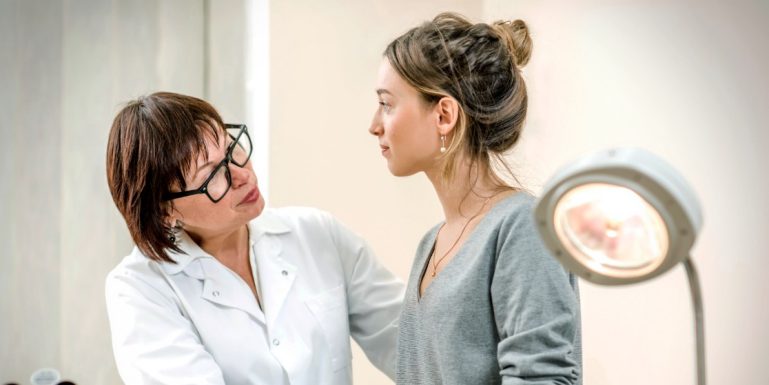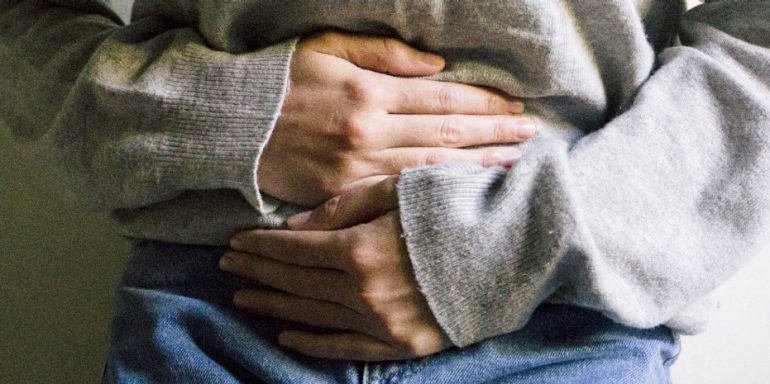
What is endometriosis? From diagnosis to treatment
When endometrial cells grow outside the womb, it can lead to significant pain and to infertility. In Switzerland, 1 in 10 women suffer from endometriosis. What is endometriosis? And what helps to prevent it? About the causes, diagnosis and treatment.
Lower abdominal cramps, back pain, fatigue, intestinal problems: every month, women with endometriosis suffer these agonising symptoms. Since they can be mistaken for regular period pain, it often takes several years to get a diagnosis.
It was the same for Flawia Visetti. Her doctors told her that the pain was just normal. In the video, she relates her long and difficult wait for a diagnosis.
Endometriosis – what is it?
In endometriosis, the womb lining, also known as the endometrium, does not stay where it belongs – in the womb. It migrates around the body and grows anywhere, usually in the abdomen. It often attaches to the ovaries, peritoneum, bladder, the womb or between the vagina and intestines. These cells do not forget their original purpose, and subsequently grow and bleed during the cycle.
Unlike with periods, however, the blood and mucus cannot discharge through the vagina, but remain in the body. For many women, this results in cysts, infections and adhesions, which can cause severe pain. The growths are benign, but still potentially require treatment.
Endometriosis symptoms
How the condition manifests varies from woman to woman. The extent of spread in the body is not related to the symptoms; smaller sites can cause severe pain, while women with extensive sites may not be aware of their condition.
Possible indications of endometriosis:
- Severe lower abdominal pain before and during the period
- Pain during ovulation
- Heavy or prolonged periods
- (Significant) lower abdominal pain independent of periods
- Pain during or after sex
- Bloated stomach during periods
- Pain when passing water or stool
- Blood in the stool or urine
- Digestion problems (diarrhoea, constipation, nausea, a feeling of fullness)
- Inability to conceive children
- Lack of energy and drive
- Back pain
Women affected by severe symptoms may scarcely be able to cope with their work or everyday life. Their life is very restricted in the acute phase and depends wholly on their cycle. People often only find out about the illness when seeking medical advice due to an inability to conceive children. This is because the symptoms are frequently mistaken for normal period symptoms.
When is a consultation to check for endometriosis necessary?
In general, anything that goes beyond a slight twinge and discomfort and which prevents full participation in daily life should be examined by a doctor – because both endometriosis and period pain can be treated. If it is a case of endometriosis, this is progressive. The endometriosis sites can grow in to other tissue, causing permanent damage. Endometriosis also has an impact on hormonal balance and the immune system.
Diagnosis – how can endometriosis be recognised?
Medical history plays an important role in identifying endometriosis. Questions are asked about a family history of endometriosis, current symptoms, bowel movements, urination and sexuality.
Sometimes, sites of endometriosis between the intestine and vagina are palpable during gynaecological examinations. Larger sites and cysts outside the womb can be found with an ultrasound examination. However, small sites or endometrial cells that have grown in the womb muscles cannot be detected by ultrasound nor by magnetic resonance imaging (MRI).
In most cases, diagnosing endometriosis therefore requires a laparoscopy for a reliable detection of the illness.
Are you unsure whether you have endometriosis? Keeping a pain diary can help with the diagnosis. Note down the following points: when and in what situations does pain occur? Is there a connection to your cycle?
Endometriosis – causes and risk factors
The cause of endometriosis is still not fully understood by scientists. A common explanation is that during your period, some menstrual blood flows back along the Fallopian tubes into the abdomen.
The cells grow uncontrollably, attack organs, try to attach to the circulatory system and may spread locally or throughout the body. Endometriosis is a master of metamorphosis and difficult to recognise, which is why it is sometimes called a “medical chameleon”. Genes are also a factor in the development of endometriosis.
Statistically, women with the following characteristics often suffer from endometriosis:
- Their mother suffered from endometriosis
- Early first period
- Short cycle and longer bleeding
- Surgery on the womb
- Late first pregnancy
It is now assumed that endometriosis is hereditary, meaning that genes play a role in its development. The risk generally increases if a woman’s mother suffered from endometriosis. Severe endometriosis is also more likely to be inherited. But even if endometriosis is hereditary, it remains unclear how high the risk is. For endometriosis to develop, numerous factors apply: alongside genes, other external influences on hormones, inflammatory processes or the immune system are also relevant.
Living with endometriosis
Around 1 in 10 women in Switzerland suffer from endometriosis. Flawia Visetti is one of them. In the video, she provides her tips on how to cope with the monthly pain.
Endometriosis: treatment and therapy
Endometriosis is a chronic inflammatory disorder. It can be treated but cannot always be cured. Treating endometriosis can involve medication, hormones or an operation. Specialists recommend a combination of different treatment methods. There is good news for older sufferers: normally, the symptoms disappear by themselves during menopause. After a woman’s last period, there should no longer be any risk of endometriosis.
A laparoscopy is not just to aid diagnosis. It is also the best method of removing endometriosis sites from the lower abdomen. The inside of the abdomen is examined during the operation. The endometriosis sites are then either targeted by vaporisation with a high-frequency current, heat or laser, or are surgically removed.
How long does an endometriosis operation last? A diagnostic laparoscopy lasts around 30 minutes. A treatment laparoscopy, in which adhesions or extensive endometriosis sites are removed, can take up to two hours. It is possible for new sites to subsequently form after an endometriosis operation.
Depending on the severity of the pain, anti-inflammatory painkillers containing active substances such as ibuprofen or naproxen or stronger prescription painkillers may help. Be sure to consult your doctor about using painkillers.
Many women with endometriosis suffer from pelvic floor muscle tension. Breathing and relaxation exercises can relax the pelvic floor. Targeted pelvic floor training also helps bladder weakness.
If the menstrual cycle is interrupted, the endometriosis also eases. It sounds simple, but if a woman does not have her period, she also has no pain. Progesterone is often used for this. It suppresses your cycle and periods. Progesterone is natural, as the female body also produces it itself. The treatment also affects the normal womb lining. This results in stopping a woman’s period.
Another type of hormone therapy is taking GnRH (gonadotropin-releasing hormone) analogues. This synthetic hormone artificially induces menopause – but brings with it all the typical symptoms: hot flushes, headaches, fatigue and osteoporosis. GnRH should only be taken for a short time under strict medical supervision. The decision to take GnRH should be very carefully considered.
Hormone therapy is not recommended if you are trying to conceive. It has a contraceptive effect. However, hormone therapy is recommended by specialists in the event of a future desire to conceive.
Specialists recommend various complementary treatments in addition to conventional medicine:
TCM: Both acupuncture and Chinese herbal medicine can help to ease pain.
Traditional homeopathy: Natural hormone therapy with oestrogen or progesterone can relieve pain.
Herbal medicine: Typical medicinal herbs for women with anti-inflammatory and hormone-regulating properties can support other treatments. These include raspberry leaf and lady’s mantle, which regulate the hormone balance and strengthen the womb. Mistletoe also has potential for success, but there are no conclusive studies on this.
Stress reduction: Japanese researchers have found that alleviating stress can reduce the progression of endometriosis. Either way, it’s true that chronic pain can alter muscle tone and lead to muscle tension. Relaxation techniques help to relieve this tension and ease pain.
Is it possible to get pregnant with endometriosis?
Struggling to get pregnant? An inability to conceive can be caused by severe endometriosis. First, the good news: you can still get pregnant, even with endometriosis.
Endometriosis can cause mucosal spread, adhesions and scarring in the Fallopian tubes or ovaries and can prevent sperm from freely reaching the eggs. Inflammation can prevent fertilised eggs from implanting in the womb lining, or the quality of the eggs decreases. Infertility is particularly common when the peritoneum is inflamed by endometriosis.
The likelihood of pregnancy increases with an operation to remove the site of endometriosis. If you have endometriosis and are planning to have children, it is advisable to seek counselling at a fertility centre, in order to clarify whether endometriosis is the real reason for the infertility. And to see whether artificial insemination might be necessary – or whether you can get pregnant naturally despite having endometriosis.
Endometriosis also increases the risk of complications during pregnancy. It is therefore essential that you attend all check-up appointments.
Diet with endometriosis
The right diet can alleviate endometriosis symptoms and pain. Eating a mainly alkaline, anti-inflammatory diet is recommended to stop the inflammatory processes in the body and to have a positive influence on hormone balance. The following foods have a positive or negative effect on endometriosis and well-being. Try them out and see what works for you personally.
What should you eat when you have endometriosis?
- Healthy fats, such as olive oil and omega-3 fatty acids, improve the metabolism. Omega-3 polyunsaturated fatty acids, for example, are contained in linseed oil or rapeseed oil and fatty fish such as salmon and herring.
- Selenium, zinc and vitamins E and C have an anti-inflammatory effect. You can get these from food such as nuts, lentils and currants.
- Fibre in wholegrain products, fruit and vegetables lowers oestrogen levels. You can get the same effect from cutting out alcohol or losing excess weight. Oestrogen is a significant factor in the development of endometriosis.
- Wholegrain products, nuts and beans also contain a great deal of magnesium. Minerals help to prevent muscle cramps and support hormonal balance.
What should you avoid eating with endometriosis?
- Avoid products with cow's milk for one week before your period. This can help alleviate pain.
- Meat and other animal proteins enhance inflammatory processes. Sausages also contain a lot of histamine. This messenger substance also affects the womb and can intensify the pain.
- Sugar, white flour products and fast food (e.g. chips) influence hormones and inflammation levels via insulin, so these foods should be eaten in moderation.
Our health advisors can provide you with useful information.
Endometriosis is an often misjudged disease, but it is easily treatable – and, in the best case, curable. So talk to your gynaecologist about your symptoms to get to the bottom of them early on.

The expert provided the editorial team with advice and input for this article. Nadia Cifarelli (BSc Psychology, certified holistic health advisor) works for the Helsana health consultation service. She helps customers on issues to do with prevention, nutrition and mental health.


Newsletter
Find out more about current health issues every month and get all the information you need about our attractive offers from all Helsana Group companies * delivered by e-mail to read whenever it suits you. Our newsletter is free of charge and you can sign up here:
We did not receive your information. Please try again later.
* The Helsana Group comprises Helsana Insurance Company Ltd, Helsana Supplementary Insurances Ltd and Helsana Accidents Ltd.